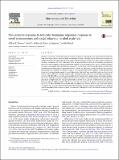Files in this item
Peri-pubertal exposure to testicular hormones organizes response to novel environments and social behaviour in adult male rats
Item metadata
| dc.contributor.author | Brown, Gillian R. | |
| dc.contributor.author | Kulbarsh, Kyle D. | |
| dc.contributor.author | Spencer, Karen A. | |
| dc.contributor.author | Duval, Camille | |
| dc.date.accessioned | 2015-08-25T14:40:01Z | |
| dc.date.available | 2015-08-25T14:40:01Z | |
| dc.date.issued | 2015-07 | |
| dc.identifier | 199783314 | |
| dc.identifier | b19a8cdd-3136-42c5-ae12-c3b3d0692d0a | |
| dc.identifier | 84937912725 | |
| dc.identifier | 000360251800017 | |
| dc.identifier.citation | Brown , G R , Kulbarsh , K D , Spencer , K A & Duval , C 2015 , ' Peri-pubertal exposure to testicular hormones organizes response to novel environments and social behaviour in adult male rats ' , Hormones and Behavior , vol. 73 , pp. 135–141 . https://doi.org/10.1016/j.yhbeh.2015.07.003 | en |
| dc.identifier.issn | 0018-506X | |
| dc.identifier.other | ORCID: /0000-0002-0675-0780/work/60195746 | |
| dc.identifier.other | ORCID: /0000-0002-2851-9379/work/78204984 | |
| dc.identifier.uri | https://hdl.handle.net/10023/7326 | |
| dc.description | Funding was received from the Wellcome Trust ISSF (grant ID 097831/Z/11/Z) scheme, awarded to the University of St Andrews. | en |
| dc.description.abstract | Previous research has shown that exposure to testicular hormones during the peri-pubertal period of life has long-term, organizational effects on adult sexual behaviour and underlying neural mechanisms in laboratory rodents. However, the organizational effects of peri-pubertal testicular hormones on other aspects of behaviour and brain function are less well understood. Here, we investigated the effects of manipulating peri-pubertal testicular hormone exposure on later behavioural responses to novel environments and on hormone receptors in various brain regions that are involved in response to novelty. Male rodents generally spend less time in the exposed areas of novel environments than females, and this sex difference emerges during the peri-pubertal period. Male Lister-hooded rats (Rattus norvegicus) were castrated either before puberty or after puberty, then tested in three novel environments (elevated plus-maze, light–dark box, open field) and in an object/social novelty task in adulthood. Androgen receptor (AR), oestrogen receptor (ER1) and corticotropin-releasing factor receptor (CRF-R2) mRNA expression were quantified in the hypothalamus, hippocampus and medial amygdala. The results showed that pre-pubertally castrated males spent more time in the exposed areas of the elevated-plus maze and light–dark box than post-pubertally castrated males, and also confirmed that peri-pubertal hormone exposure influences later response to an opposite-sex conspecific. Hormone receptor gene expression levels did not differ between pre-pubertally and post-pubertally castrated males in any of the brain regions examined. This study therefore demonstrates that testicular hormone exposure during the peri-pubertal period masculinizes later response to novel environments, although the neural mechanisms remain to be fully elucidated. | |
| dc.format.extent | 7 | |
| dc.format.extent | 416787 | |
| dc.language.iso | eng | |
| dc.relation.ispartof | Hormones and Behavior | en |
| dc.subject | Adolescence | en |
| dc.subject | Testosterone | en |
| dc.subject | Sex differences | en |
| dc.subject | Exploration | en |
| dc.subject | Sexual behavior | en |
| dc.subject | Castration | en |
| dc.subject | RC0321 Neuroscience. Biological psychiatry. Neuropsychiatry | en |
| dc.subject | NDAS | en |
| dc.subject | BDC | en |
| dc.subject.lcc | RC0321 | en |
| dc.title | Peri-pubertal exposure to testicular hormones organizes response to novel environments and social behaviour in adult male rats | en |
| dc.type | Journal article | en |
| dc.contributor.sponsor | The Wellcome Trust | en |
| dc.contributor.institution | University of St Andrews. Centre for Social Learning & Cognitive Evolution | en |
| dc.contributor.institution | University of St Andrews. School of Psychology and Neuroscience | en |
| dc.identifier.doi | https://doi.org/10.1016/j.yhbeh.2015.07.003 | |
| dc.description.status | Peer reviewed | en |
| dc.identifier.grantnumber | 097831/z/11/z | en |
This item appears in the following Collection(s)
Items in the St Andrews Research Repository are protected by copyright, with all rights reserved, unless otherwise indicated.

